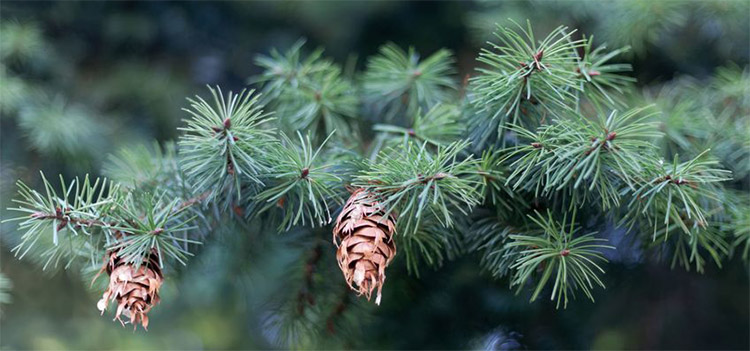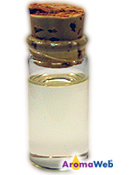Douglas Fir Essential Oil
Pseudotsuga menziesii

Description
Douglas Fir Essential Oil offers a somewhat sweeter and more complex aroma when compared to the aroma of other conifer needle oils. I find it to be woody and characteristically pine-like, but it also features layers of citrus and floral notes. It certainly is a beautiful conifer oil to use during the holidays, but I take advantage of its benefits year round. I love how Neryls Purchon and Lora Cantele describe it as "Imagine walking into a florist's shop at Christmas and inhaling the collective aroma of the pine boughs on display along with all the flowers - that's Douglas fir." [Reference: Neryls Purchon and Lora Cantele, Complete Aromatherapy & Essential Oils Handbook for Everyday Wellness (Toronto ON: Robert Rose, 2014), 57.]

From a review of various GC/MS reports, Douglas Fir Oil does vary in composition, but it tends to be comprised of approximately 70-80% monoterpenes, particularly alpha and beta Pinene, Sabinene, and Terpinolene. It also tends to be comprised of approximately 5-15% esters, particularly Citronellyl acetate and Geranyl acetate. The esters contribute to its slightly fruity, floral aroma.
Aromatically, I find that it blends well with other conifer and wood essential oils such as Siberian Fir, Silver Fir and Virginian Cedarwood. I also love to blend it with citrus oils, particularly Sweet Orange, Bergamot and Grapefruit. It also smells lovely when combined with Lavender. Around Christmas, it's beautiful to combine with a hint of Peppermint and other conifer essential oils.
Steffen Arctander indicates that he believes that Douglas Fir Oil is worth exploring as a natural fixative and he describes Douglas Fir Needle Oil as possessing "a very rich bodynote and a great odor tenacity..." [Reference: Steffen Arctander, Perfume and Flavor Materials of Natural Origin (Reprint Edition. Elizabeth, NJ: Pathfinder., 2017), 217.]
Douglas Fir is also known as Oregon Pine. The tree does not fall within the traditional fir Genus of Abies and is not considered to be a true fir tree. You may see the tree sometimes spelled with a hyphen as in Douglas-fir, and I believe the reason is to distinguish it from traditional Abies Genus firs such as Siberian Fir (Abies sibirica) and Silver Fir (Abies alba).
As with most conifer needle oils, I find Douglas Fir Essential Oil to be emotionally uplifting and stimulating yet comforting.
For more information about fir and conifer oils, read AromaWeb's Guide to Coniferous Essential Oils.
Douglas Fir Essential Oil Benefits and Uses
- Diarrhea
- Cystitis
- Colitis
- Colds/Flu
- Emotionally Uplifting
Reference: Neryls Purchon and Lora Cantele, Complete Aromatherapy & Essential Oils Handbook for Everyday Wellness (Toronto ON: Robert Rose, 2014), 57.
Botanical Name of Douglas Fir Essential Oil
Plant Family
Common Method of Extraction
Steam Distilled
Plant Part Typically Used
Color
Clear to Pale Yellow
Consistency
Thin
Perfumery Note
Top
Strength of Initial Aroma
Medium - Strong
Aromatic Description
Coniferous and woody with floral and citrus notes.
Sustainability and Conservation Status
Least Concern
Source: https://www.iucnredlist.org/species/42429/2979531
To learn more about the conservation status of essential oil bearing plants and how to use the IUCN Red List of Threatened Species, please refer to AromaWeb's Guide to Essential Oils and Sustainability.
Major Constituents
- Camphene
- a-Pinene
- B-Pinene
- Bornyl acetate
- Terpinolene
- Sabinene
- Terpinen-4-ol
Reference: K.H. Kubeczka, W. Schultze. Biology and Chemistry of Conifer Oils. (Flavour & Fragrance Journal 2, 1987), 137-148. Source cited in Robert Tisserand and Rodney Young, Essential Oil Safety (Second Edition. United Kingdom: Churchill Livingstone Elsevier, 2014), 281.
Douglas Fir Essential Oil Safety Information
Tisserand and Young do not indicate any special precautions when using Douglas Fir Essential Oil. However, they precaution to avoid use of the oil if it has oxidized. Reading Tisserand and Young's full profile is recommended. [Reference: Robert Tisserand and Rodney Young, Essential Oil Safety (Second Edition. United Kingdom: Churchill Livingstone Elsevier, 2014), 282.]
General Safety Information
Do not take any oils internally and do not apply undiluted essential oils, absolutes, CO2s or other concentrated essences onto the skin without advanced essential oil knowledge or consultation from a qualified aromatherapy practitioner. For general dilution information, read AromaWeb's Guide to Diluting Essential Oils. If you are pregnant, epileptic, have liver damage, have cancer, or have any other medical problem, use oils only under the proper guidance of a qualified aromatherapy practitioner. Use extreme caution when using oils with children and be sure to first read the recommended dilution ratios for children. Consult a qualified aromatherapy practitioner before using oils with children, the elderly, if you have medical issues or are taking medications. Before using this or any essential oil, carefully read AromaWeb's Essential Oil Safety Information page. For in-depth information on oil safety issues, read Essential Oil Safety by Robert Tisserand and Rodney Young.
Shelf Life
Important Information About the Profiles
The essential oil information provided on AromaWeb is intended for basic educational purposes only. The references to safety information, test results, constituents and percentages is generalized information. Essential oils can vary greatly in composition. The data is not necessary complete and is not guaranteed to be accurate. The essential oil photos are intended to represent the typical and approximate color of each essential oil. However, essential oil composition and color can vary based on harvesting, distillation, age of the essential oil and other factors. Profiles for several CO2 Extracts and absolutes are included within the directory, and are denoted as such.
